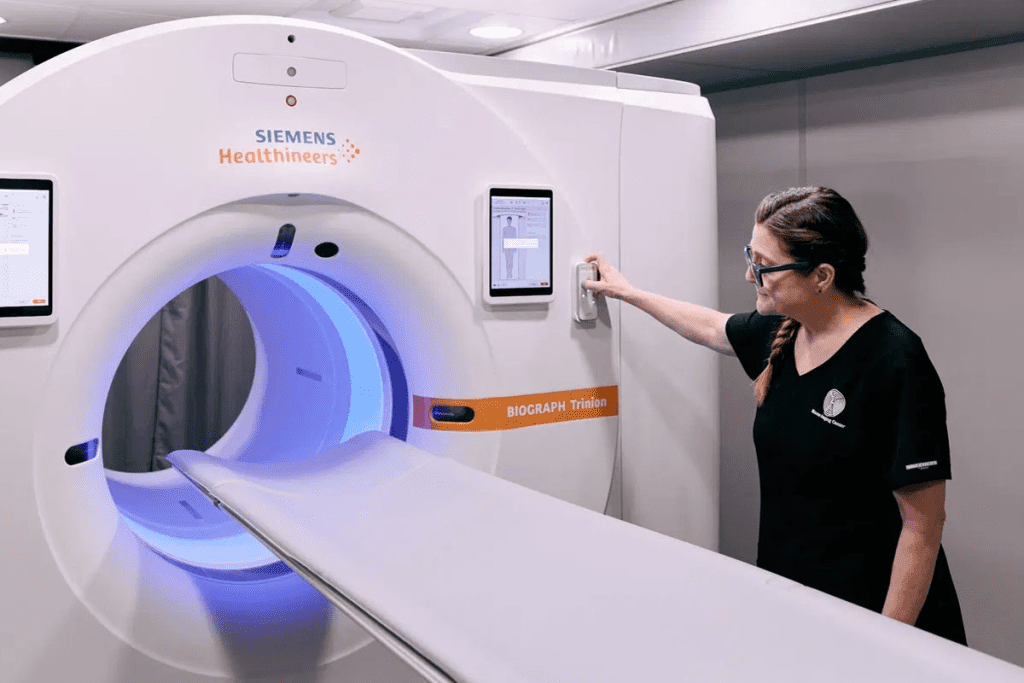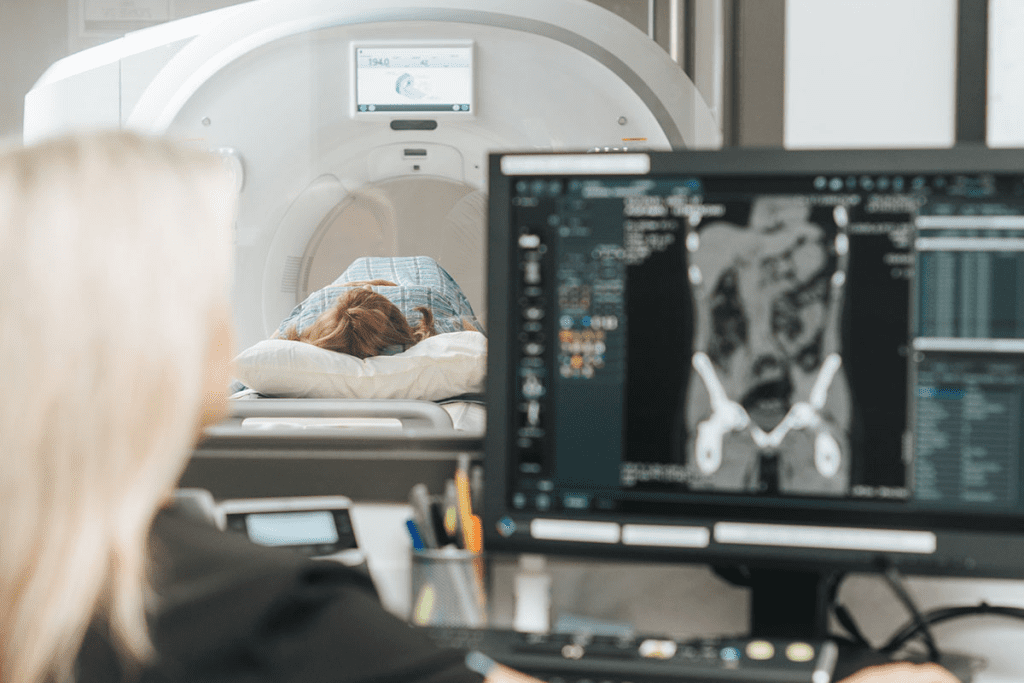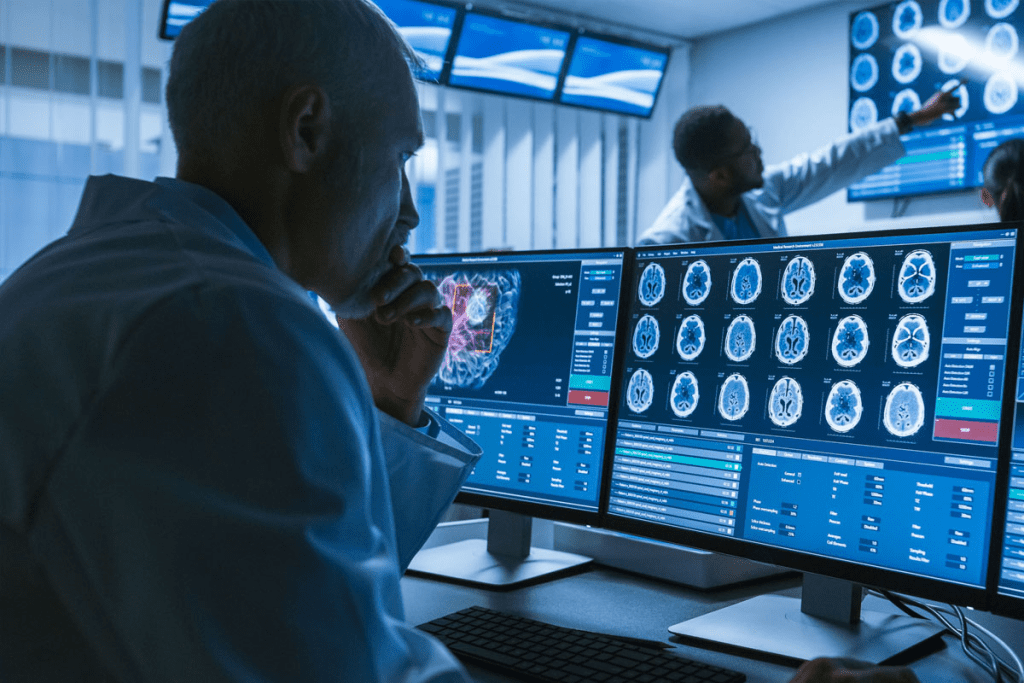Last Updated on October 22, 2025 by mcelik

When considering PET scan vs CT scan detection capabilities, the real advantage comes from combining both. A PET/CT scan merges structural detail with metabolic insight, giving doctors a more complete picture. This leads to more accurate diagnoses and better treatment planning.
Knowing what each scan does helps patients and doctors choose the best tests.
Medical imaging has changed a lot, giving us new ways to see inside the body. This change has made patient care better and treatments more effective.
Diagnostic imaging started with Wilhelm Conrad Röntgen’s discovery of X-rays in 1895. New imaging methods have made it possible to see more inside the body. Computed Tomography (CT) scans and Positron Emission Tomography (PET) scans are key examples of these advancements.
CT scans show detailed structural images, helping us see body parts clearly. PET scans, on the other hand, show functional images. They help us see how the body works and what it’s doing.
Modern medicine relies on advanced imaging like PET and CT scans. They help doctors make accurate diagnoses and decide on treatments. These tools are vital in fields like oncology, neurology, and cardiology.
| Imaging Modality | Primary Use | Key Benefits |
| CT Scan | Structural Imaging | High-resolution anatomical images, quick scanning time |
| PET Scan | Functional Imaging | Assessment of metabolic activity, early detection of diseases |
Using PET and CT together has made diagnosis even better. It gives a full picture of the body’s structure and function.

CT scanning is a key part of modern medicine. It gives doctors detailed views of the body’s inside. This helps them find and treat many health problems.
CT scans use X-rays to make detailed pictures of the body. A CT scanner, shaped like a doughnut, moves around the patient. It sends out X-rays from different sides.
The X-rays that go through the body are caught by sensors. Then, the computer makes images from this data. This lets doctors see inside the body and find problems like tumors or injuries.
The CT scanning process includes a few main steps:
CT scans are great for seeing inside the body. They show organs, bones, and soft tissues clearly. This makes them very useful for finding injuries, cancers, and vascular diseases.
The detailed pictures from CT scans help doctors see the size, shape, and location of body parts. They can also spot any problems.
There are many types of CT scans, each for different uses:
These CT scan types let doctors choose the best imaging for each patient and condition.

PET scanning technology shows how the body works by looking at metabolic activity. It’s different from other imaging methods that just show body structure. PET scans are great for finding and tracking diseases, like cancer.
PET imaging works by using radiopharmaceuticals that find active areas in the body. This is key in finding tumors because they use more energy than normal tissues.
First, a radiopharmaceutical, like Fluorodeoxyglucose (FDG), is injected. This is a sugar molecule with a radioactive tag. It lights up areas that take up a lot of sugar, like cancer cells, during the scan.
PET scans show how tissues work, not just their shape. This is important for catching diseases early and seeing how treatments work. It helps tell apart live tumor cells from dead ones.
The type of radiopharmaceutical used depends on the scan’s purpose. FDG is often used for cancer, but other tracers are for heart health or specific tumors.
In short, PET scanning is a powerful tool in medicine. It helps doctors understand how the body works and find diseases early. Its ability to spot metabolic changes is very valuable.
It’s important to know how PET and CT scans work to make accurate diagnoses. They use different technologies to show different things.
PET scans find metabolic activity in the body. They use special drugs that go to active areas, like growing cancer cells. CT scans, on the other hand, use X-rays to show detailed body structures.
PET scans are great at finding functional changes. This makes them perfect for spotting active tissues. They’re key in finding and understanding cancer.
CT scans are better at showing body structures. They give clear pictures of organs, bones, and soft tissues. They’re great in emergencies to quickly see damage.
PET scans, on the other hand, show metabolic processes. They help doctors find areas of abnormal activity. This is very helpful in finding cancer.
When we compare PET and CT scans, we see their strengths. PET scans are better at finding active lesions. CT scans are better at showing body structures.
“The combination of PET and CT scans can significantly enhance diagnostic accuracy by providing both functional and anatomical information.”
A study showed PET scans are better at finding cancer early. CT scans are better at finding structural problems.
In short, knowing how PET and CT scans work is key. It helps doctors choose the best tool for each case.
Cancer detection with CT scans depends on tumor size and density. This method is key for detailed body images. It helps spot and stage cancer.
Tumors must be a certain size and density to show up on CT scans. Smaller tumors or those blending in with tissue are hard to see. The scanner’s quality and the scan protocol matter too.
CT scans are great for showing body changes, like tumors and their effects. They can spot structural abnormalities, like masses or big lymph nodes. But, telling if these changes are cancerous can be tricky.
CT scans might miss cancers in some cases. Early-stage cancers or tumors that look like the tissue around them are hard to find. Tumors in complex areas or hidden by other structures are also tough to see.
In summary, CT scans are very useful for finding cancer. But, knowing their strengths and weaknesses is key for correct diagnosis and treatment.
PET scans look at how tissues work, not just their shape. This is key because tumors often use more energy than normal cells.
PET scans find tumors by looking at their energy use. Cancer cells eat more sugar than regular cells. This is seen with special PET scans.
Key advantages of using metabolic activity as a marker include:
PET scans spot small or early tumors that CT scans miss. Finding these early is key for treating cancer well.
“The use of PET scans in oncology has revolutionized the field by enabling the detection of cancer at stages when it is more treatable.”
Oncologist
PET scans can tell apart live tumor cells from dead ones. Knowing this helps doctors see if treatments are working.
A viable tumor shows up as active on a PET scan. But necrotic tissue does not.
It’s key to know how PET and CT scans work for spotting metastatic disease. This is because they help doctors make the right treatment plans. Spotting metastatic disease is a big challenge, needing precise checks to guide treatment.
Checking lymph nodes is vital in cancer staging. CT scans look at size to spot possible cancerous nodes. But, they might miss cancer in normal-sized nodes or tell the difference between cancer and inflammation.
PET scans, though, look at how active nodes are, not just their size. This helps find cancer in nodes that look normal but might have tiny cancer cells.
Finding distant metastases is key for cancer staging and treatment planning. PET scans are great at finding these, thanks to their ability to spot high glucose use in cancer cells. This is because cancer cells use more glucose than normal cells.
CT scans, though, look for changes in the body’s structure. They’re good at finding big changes but might miss small or early metastases.
Bone metastases can change bones in two ways: structurally and metabolically. CT scans are good at finding structural changes like lesions. But, they might not see the metabolic activity in these changes.
PET scans, like those using 18F-Fluoride, can spot metabolic changes in bones. They often find metastases before CT scans by showing where bone turnover is high.
After cancer treatment, it’s key to check how well the treatment worked. Choosing between CT and PET scans is important. They help tell if scar tissue or cancer is present.
It’s hard to tell scar tissue from cancer after treatment. PET scans are great because they show metabolic activity. Cancer cells use more energy than scar tissue, so PET scans can spot cancer better.
It’s important to know how well treatment is working. CT scans look at tumor size to see if treatment is effective. But PET scans can show changes in metabolic activity sooner.
Things to consider include:
Using both CT and PET scans helps doctors make better decisions. They can tailor treatment plans to each patient’s needs.
PET/CT imaging fusion technology has changed the game in diagnostic imaging. It gives us both the body’s structure and how it works. This combo boosts the accuracy of diagnoses and treatment plans.
PET and CT imaging together in one scan fixes their own flaws. PET scans show how the body’s cells are working. CT scans give us detailed pictures of the body’s parts. Together, PET/CT scans give us a full picture of the body’s health.
The benefits of PET/CT imaging include:
PET/CT imaging has made a big difference, mainly in cancer care. It helps doctors diagnose better, cuts down on extra tests, and improves patient results.
Some key uses of PET/CT imaging are:
In short, PET/CT scans are a game-changer in medical imaging. They offer both structure and function info. This leads to more accurate diagnoses, better treatment plans, and improved patient care.
Radiation exposure is a key part of CT and PET scans. It’s important to think about the benefits and risks. These scans help doctors make important decisions that can change a patient’s life. But, they use ionizing radiation, so we must be careful.
CT scans use X-rays to see inside the body. The dose depends on the scan type, body part, and scanner. Modern scanners aim to use less radiation while keeping images clear. For example, a CT scan of the abdomen might give about 10 millisieverts (mSv).
Effective dose is how we measure CT radiation. It considers how much radiation different parts of the body absorb. The American College of Radiology says it’s key to lower doses without losing image quality.
PET scans use special tracers that give off positrons. The radiation comes from these tracers, like FDG (fluorodeoxyglucose). The dose from a PET scan depends on the tracer amount and scan type. A typical PET scan might give about 7 mSv.
“The administration of PET tracers must be carefully planned to ensure that the radiation exposure is justified by the diagnostic benefit.” –
Guidelines for PET Imaging
Choosing between CT and PET scans is a careful decision. It’s about weighing the benefits against the risks of radiation. This is very important for kids and when scans are needed again. Ways to lower radiation include using other imaging, optimizing scans, and only doing them when needed.
Understanding how radiation exposure works helps doctors use CT and PET scans wisely. This way, they can help patients while keeping them safe from too much radiation.
PET scans are often chosen over CT scans because they show how the body’s cells work. This is key in diagnosing and treating diseases where cell activity matters a lot.
In cancer care, PET scans are key for cancer diagnosis and staging. They spot the activity of tumors, helping tell if they are cancerous. This is vital for planning treatment.
PET scans help track how well treatments work. This lets doctors make changes early on to help patients better.
PET scans check brain function and metabolism in neurology. They’re great for spotting diseases like Alzheimer’s. They find where brain activity is low, linked to memory loss.
They also help find where seizures start, guiding surgery. PET scans give a full picture of brain health, alongside CT or MRI scans.
In heart health, PET scans look at myocardial viability and perfusion. They see how heart muscle works, helping decide treatment for heart disease or failure.
PET scans find healthy but dormant heart areas. This info is key for choosing the right treatments, improving heart health.
CT scans are often chosen over PET scans in some medical cases. This is because CT scans are faster, more available, and show detailed structural information. These qualities make CT scans very useful in certain medical situations.
In emergency and trauma cases, quick and accurate injury assessment is key. CT scans are often the preferred imaging modality because they scan fast and are available 24/7. This speed is vital in trauma care, where quick decisions can greatly impact patient recovery.
CT scans show detailed images of bones, soft tissues, and blood vessels. They help doctors spot internal injuries that can’t be seen by touch alone. For example, in head trauma, a CT scan can quickly find hemorrhages or fractures, helping doctors make immediate treatment plans.
For many medical needs, a detailed look at the body’s structures is essential. CT scans excel in providing high-resolution images of complex structures. This makes them very useful for planning surgeries or understanding disease extent.
In complex fractures or vascular diseases, CT scans offer critical detail for accurate diagnosis and treatment planning. Their ability to show anatomy in three dimensions adds to their value in these cases.
Cost and availability also play a big role in choosing CT scans over PET scans. CT scanners are more widely available and cheaper to run than PET scanners. This makes CT scans a more accessible diagnostic tool for many patients.
This cost-effectiveness, along with CT scans’ diagnostic abilities, makes them a top choice for many medical uses. This is where the specific benefits of PET scans are not needed.
Medical imaging is getting better, thanks to new PET and CT tech. These advancements will help doctors diagnose diseases more accurately. They will also improve patient care.
New PET tracers are coming, which could change how we fight diseases. These tracers target specific body processes. They might help find diseases sooner and tailor treatments better.
A study found new PET tracers could boost cancer diagnosis by 20% in some cases.
| Tracer | Application | Potential Impact |
| 18F-FLT | Oncology | Assessing tumor proliferation rates |
| 18F-NaF | Cardiology | Identifying vulnerable atherosclerotic plaques |
| 18F-Florbetaben | Neurology | Diagnosing Alzheimer’s disease |
“The development of new PET tracers is a significant step forward in our ability to diagnose and treat diseases at an early stage.” A Nuclear Medicine Specialist
CT tech is also getting better, with clearer images and less radiation. These changes are key to better pictures and safer patients.
Some big improvements include:
As these techs keep improving, we’ll see better diagnosis and safer patients. AI and machine learning will also play a big role in future medical imaging.
The choice between PET and CT scans depends on the situation and what’s needed for patient care. Both have their own strengths and will keep being key in medical imaging.
PET scans are great at showing metabolic activity. This makes them very useful for finding cancer and checking how treatments are working. On the other hand, CT scans give detailed views of the body’s structure. They’re best for urgent and trauma cases.
The future of medical imaging looks bright with both PET and CT scans getting better. New PET tracers and CT tech will improve how we diagnose diseases. This will help doctors make better decisions and care for patients.
As medical imaging gets more advanced, using both PET and CT scans together will be even more important. It’s vital for healthcare professionals to know the good and bad of each. This way, they can make the best choices for their patients.
A PET scan shows how cells work by looking at their activity. A CT scan, on the other hand, shows the body’s structure in detail.
Yes, PET scans can find cancer by looking at how cells work. This is helpful for spotting small or early tumors that CT scans might miss.
PET scans are better at finding cancer that has spread because they look at cell activity. CT scans look at the body’s structure. So, PET scans are more sensitive for distant cancer and lymph nodes.
Using both PET and CT scans together gives you the best of both worlds. It improves how well you can diagnose and understand health issues.
Both scans use radiation, but CT scans use more. PET scans use special medicines that give off different kinds of radiation.
PET scans are often used in cancer care to see how tumors work. They’re also used in brain and heart health to check on certain conditions.
CT scans are better for emergency situations and detailed body checks. They’re also cheaper and easier to get than PET scans in some cases.
Yes, PET scans can tell the difference between living tumor cells and dead cells. This helps doctors see how well treatments are working.
New PET tracers are being made to find specific cancers or changes in cells. This could make PET scans even better at finding cancer.
CT technology is getting better with higher detail and lower radiation. New uses are also being found, making CT scans more useful in healthcare.
PET scans can be more sensitive for some cancers, looking at how cells work. But, how well each scan works depends on the situation.
Both scans help after treatment. PET scans look at cell activity to see how well treatment worked. CT scans show detailed body changes to check on progress.
Subscribe to our e-newsletter to stay informed about the latest innovations in the world of health and exclusive offers!